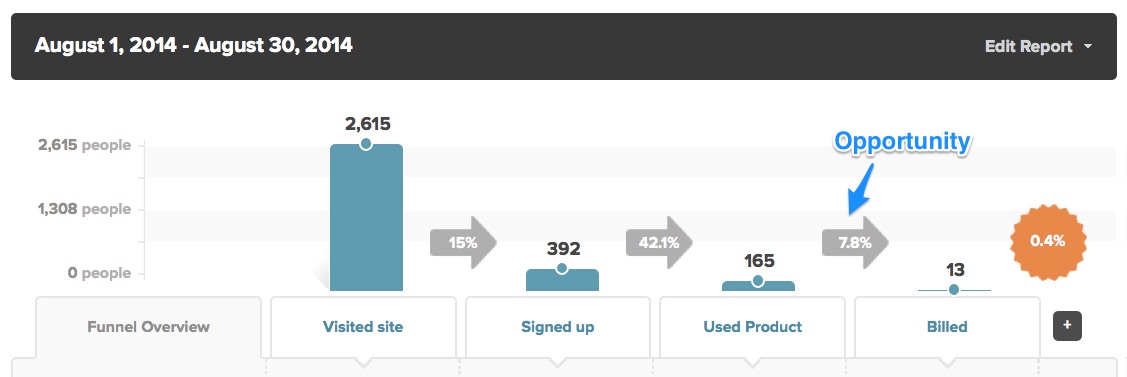If you’ve spent any time learning about marketing analytics, you’ve probably come across the term “funnels.” If you’re curious about what they are and how they can help, this post is for you.
What Are Funnels?
You undoubtedly want visitors on your website to take certain actions. Maybe you want them to make a purchase, sign up, or fill out a form. When someone does something you want them to do, it’s known as a conversion. The visitor converts from browsing to taking the action you want them to take.
A funnel is the set of steps a visitor needs to go through before they can reach the conversion.
Think about the Amazon purchase funnel. There are a few steps a visitor has to go through before they can purchase a product. Here’s how it looks:
- They have to visit Amazon.com
- They have to view a product
- They have to add a product to the cart
- They have to purchase
There are additional steps/actions that can be taken in between each of these steps, but they do not matter in the purchase funnel. For example, a visitor may view Amazon’s About page, Contact page, and Careers page, but we don’t need to count these in the funnel because they aren’t necessary steps.
Why is the set of steps to conversion called a “funnel”? Because at the beginning of the process, there are a lot of people who take the first step. Then, as the people continue along and take the next steps, some of them drop out, and the size of the crowd thins or narrows. (And even further along in the process, your sales team gets involved to help close the deal.)

The top of the funnel is where everyone goes in (visiting your site). Only the most interested buyers will move further down your funnel.
So when you hear people say “widen the funnel,” you now know what they are referring to. They want to cast a larger net by advertising to new audiences, increasing their brand awareness, adding inbound marketing, etc. in order to drive more people to their site, thus widening their funnel. The more people there are in a funnel, the wider it is.
You aren’t limited to using your funnel strictly for signing up and/or purchasing. You can put funnels all over your website to see how visitors move through a specific website flow.
You may want to track newsletter signup (Viewing newsletter signup form > Submitting form > Confirming email) or a simple page conversion (Viewing a signup page > Submitting signup). Figure out what your goals are and what you want visitors to do on your site, and you can create a funnel for it.
Once you have the data, you’ll be able to see where roadblocks are and optimize your funnel. Let’s dig a little deeper into that.
Why Funnels Are Beneficial
With a funnel report, you can see where you are losing customers.
Let’s take your average SaaS business as an example. Here’s how a funnel may look for them:
- Visited site
- Signed up for a trial
- Used product
- Upgraded to paying
Do people have to use the product before paying? They don’t, but it’s a good idea to track it so you can see if it’s a roadblock for them.
Here’s how that funnel would look in the Kissmetrics Funnel Report:

In this example, the business manages to get 165 people to use the product, but only 13 people convert to Billed. There are opportunities for improvement at every step of the funnel, but it’s important to first work on the areas that need the most attention. The more people they can convert to Billed, the more revenue they’ll have. This should be the first area of the funnel to optimize.
A Funnel in Real Life
Funnels occur everyday with consumers. Let’s look at the funnel process for a retail store and see the corresponding steps in an ecommerce store. We’ll be tracking a purchase funnel.

The Ecommerce store has the fortune of being able to see a funnel. If they use Kissmetrics, they’ll see the exact number of people that move through the funnel, and where and when they drop off in the purchase process.

Okay, so now we have an understanding of what a funnel is and why it helps. Let’s take a look at two products that offer funnels – Google Analytics and Kissmetrics.
How Google Analytics Funnels Work
Google Analytics offers funnels, and we’ve written extensively about it in the past. There are a few things you’ll need to know when creating funnels in Google Analytics:
- It’s a pretty basic funnel. If you don’t want to dive deep into the data and optimize, you can go with this.
- You cannot go back and retroactively view data. Once you create your funnel, you’ll only be able to the funnel going forward as the data comes in.
Click here to learn how to set up a conversion funnel in Google Analytics.
How Kissmetrics Funnels Work
Kissmetrics funnels, on the other hand, are simpler. You just create your events and then set up the report. Events are various actions people take on your website. These may include signing up, downloading something, clicking on something, viewing a page, using a feature, etc. Once you have these set up, you can create funnels. There are a few benefits to Kissmetrics funnels:
- You can go back and retroactively view data. Want to create a funnel that views your performance 3 months ago? No problem. As long as you were tracking data during that time, you can go back and view your performance. If you weren’t tracking data during that time, there are ways to import data into Kissmetrics.
- It doesn’t matter if people leave your funnel and then return to it and convert. In other words, they don’t have to follow a strict path. In the example funnel above, a visitor can go on other pages of your site before signing up. They don’t have to go to your homepage and then straight to signing up. If they go to your homepage, then your About page, your Contact page, and your Pricing page, and then enter signup, they’ll still be counted.
- It doesn’t matter if the conversion takes a long time to happen. As long as it’s within your date range, you can track it. Do you have people who visit your site one day and sign up 20 days later? If it’s within your date range, Kissmetrics will register the signup conversion.
- You can segment your traffic to see your most valuable segments. This can come in especially useful if you’re tracking traffic or UTM segments. Tracking these can help you find your highest converting sources. Once you know what they are, you can put more effort into getting more traffic from those sources. We covered this in this blog post on increasing conversions.
- We don’t track pageviews. Our technology tracks every person on your site. This means you can see each person in every step of your funnel. Take, for instance, the example funnel above. With the Kissmetrics funnel, you can see the people who did not convert to “Billed.” You can then email them to gather feedback and find out why they decided not to convert to paying. You can then take this information back into your product development and marketing.
Recap
We’ve gone through a fair amount, here’s a recap:
- When someone on your website does something you want them to do (i.e., sign up, make a purchase, fill out a form, etc.), it is known as a conversion.
- A funnel is used to track the steps that lead up to that conversion. For example, Ecommerce companies want people to purchase products on their website. Their funnel may have these steps – visited site > viewed product > placed product in cart > purchased.
- Using a funnel report you can see where people are dropping off in the path to conversion.
- Both Google Analytics and Kissmetrics provide funnels. Each have their unique use cases. Kissmetrics provides additional reports in addition to the Funnel Report.
Video Explanation
Want to know more about the Kissmetrics Funnel Report? Just click play below.
Ready to see how the Funnel Report and other Kissmetrics reports can be used to grow your business? Then request a personal demo today.
About the Author: Zach Bulygo (Twitter) is a Content Writer for Kissmetrics.

 As you know, I recently launched OwnerFUEL. It’s the media portion of my company, Owner. I wanted to share with you just how simple it was to launch, and what we did to get it up and running. I’ll tell you right up front that a lot of what I recommend hinges on you choosing to build on the Rainmaker platform. But I explain all the reasons why that’s the right choice.
As you know, I recently launched OwnerFUEL. It’s the media portion of my company, Owner. I wanted to share with you just how simple it was to launch, and what we did to get it up and running. I’ll tell you right up front that a lot of what I recommend hinges on you choosing to build on the Rainmaker platform. But I explain all the reasons why that’s the right choice.







 As a marketing manager at
As a marketing manager at 